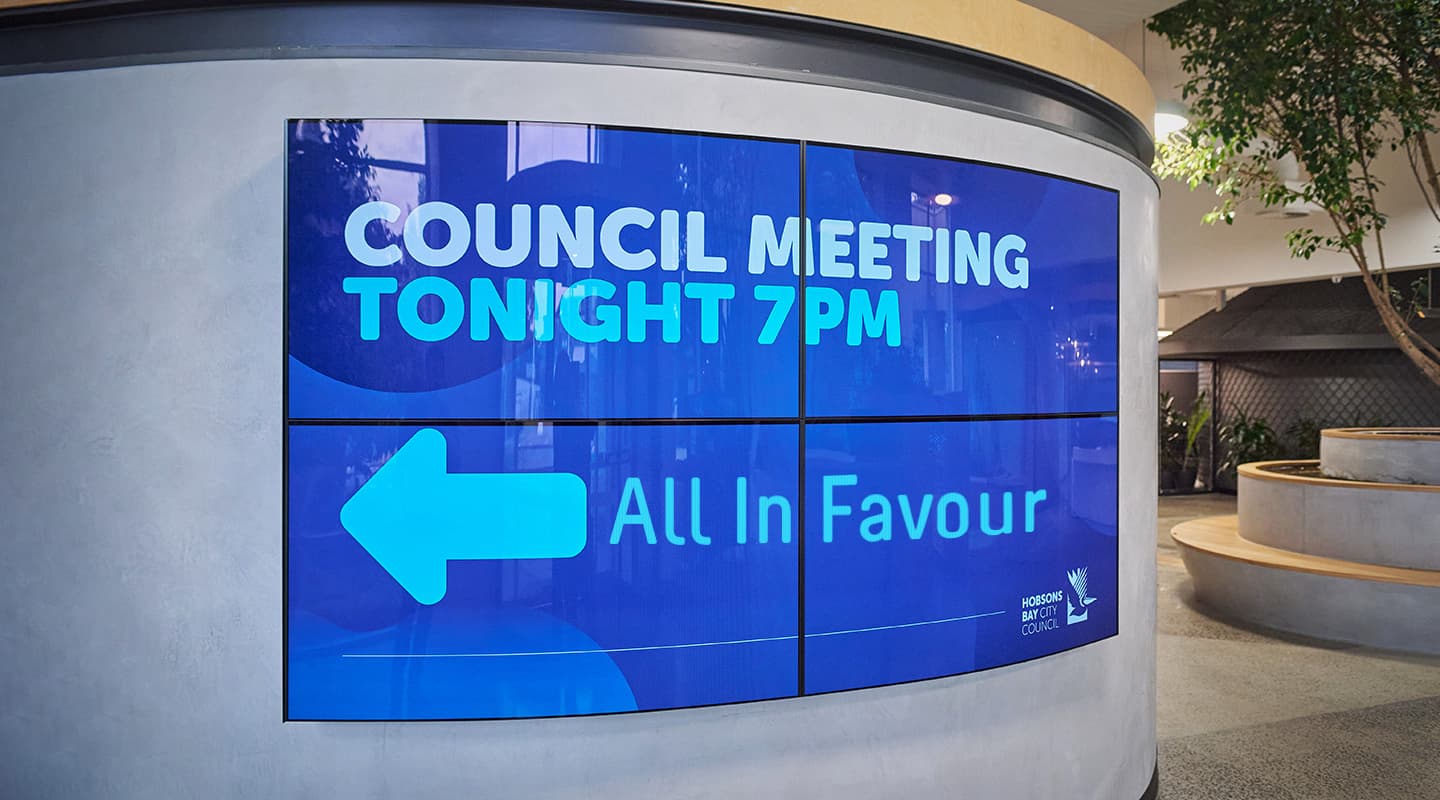
AV Case Study: Hobsons Bay Council Chambers
Converged Technology answers the call for equity at Hobsons Bay City Council meetings.
Text:/ Christopher Holder
Covid changed the workplace forever, sometimes in obvious ways (work from home) and sometimes in more nuanced ways. Hobsons Bay City Council meetings changed forever thanks to covid. The council’s Manager Digital Services, Roger Verwey, explains: “When council meetings were conducted remotely during covid there were aspects of that experience we wanted to retain. Because of the format of the Zoom call, each councillor was allotted equal real estate on the screen in Gallery mode, and for anyone viewing the meeting they could see each councillor clearly and each was titled in the Zoom captions.”
Prior to covid, Hobsons Bay Council was a streaming pioneer. This was prior to regulations being introduced to make streaming council meetings mandatory, and no one’s suggesting the set up was world’s best. That said, the Hobsons Bay Council team and the councillors themselves saw the benefit of streaming early and how it would help to shine light on the process and assist with good governance.

Hobsons Bay council chamber. Due for refurbishment soon, which is why the AV rack is on show. Hopefully they retain the chandelier!
Once in-person meetings returned, councillors often requested to join remotely. This created technical challenges around how to stream a hybrid meeting adequately, all the while aspects of the pieced-together streaming rig were failing.
At this point, council’s IT team needed at act quickly and bring in the experts to design and install a fit for purpose streaming solution. Converged Technology answered the call.
EQUAL REAL ESTATE
“The key point of difference was the equal screen real estate,” identifies Converged Technology Managing Director, James Frost. “What you might call the ‘brady bunch’ view of all the councillors.”
That ‘brady bunch’ requirement (referencing the start/end credits of the popular American sitcom of the ’70s) set off a cascade of technical decisions James and his team needed to make. That, and the stipulation that Zoom would be the VC platform of choice.

Brady Bunch: The ‘equal real estate’ view of all councillors on the stream. Viewers are largely unaware of whether a councillor is attending the meeting in person or chiming in from home.
THANKS A BUNCH
To achieve a ‘brady bunch’ tiled view of all the councillors, either remote or in the room, requires each individual having their own camera. Remotely, this is easy (thanks to high quality webcams), in-person, this means more than a couple of PTZ cameras at the back of the chamber.
James initially spec’ed everyone’s favourite miniature camera brand, Marshall, but then became sold on the fact the entire system could only be manageable if everything was on the network (in this case, NDI for video), and running SDI cable to each Marshall camera wouldn’t be practical. Instead Converged found a miniature NDI PoE camera by a company called Aida. There are 14 of these cameras in the chamber – one for each councillor plus additionals for the CEO and any other visiting presenter.
No one knew much about the brand or the camera but they’re doing the job.
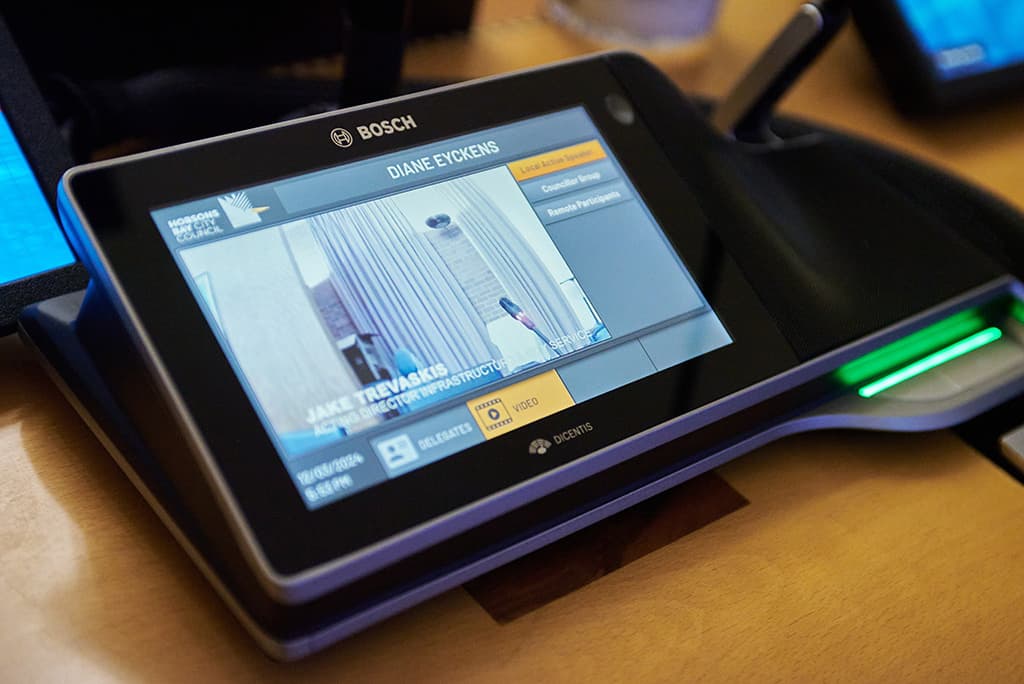
The Bosch Dicentis conferencing station plays host to the MVI software, which has been entirely customised by Converged Technology.
TIME TO TALK
At each position the Aida miniature camera is joined by a Bosch Dicentis conferencing station. The Dicentis station’s most crucial role is to provide ‘push to talk’ functionality when a councillor is presenting. When in presentation mode, the video switcher prioritises the presenter in the stream.
Dicentis is designed as a bespoke conferencing system but the special requirements of this project – ‘brady bunch’ view and integrating with Zoom to provide a stream feed that gives equal status to those in and out of the chamber – meant that James Frost and his team had to look into a third-party software video switcher. The MVI EasyConf software takes care of all the heavy lifting, managing the conferencing elements including layouts, speech time and titling, while MVI EasyCam is responsible for aggregating all 14 individual camera feeds and NDI video switching. It sits on a powerful local PC and it also commandeers the Dicentis hardware, including the onboard display which takes a feed of the active speaker.

Each desk combines a Samsung 13-inch display, an Aida lipstick camera on a custom mount and the Bosch Dicentis conferencing station.
CONFIDENCE? SURE
Completing the hardware for each councillor’s position is a 13-inch Samsung display. Typically, this screen displays the agenda or any other presentation items up for discussion. Combining the Samsung display and the Dicentis monitor, all within reach (along with the councillor’s own laptop), means relevant material and feeds are all in view without the need to swivel around or crane necks to see a shared screen.
That said, there are in-room displays, which councillors can revert to as well as providing necessary visuals for people in the gallery.
VIRTUAL SWITCH
The MVI video switching platform proved to be the software that glued the system together – along with the Q-SYS control.
If you’re thinking of taking Converged Technology’s bright idea and rolling your own council chamber AV system based on MVI, be warned, it wasn’t like shelling peas, according the James Frost: “MVI is a very effective conferencing platform in and of itself. It would have made things easier to run everything within the MVI software. We could have implemented features such as remote voting with that solution. But the council wanted Zoom. Half the complexity of the MVI integration was trying to understand how do we incorporate all of this with Zoom.”
Zoom was selected as the conferencing platform because of the councillors’ familiarity with the solution (although, MS Teams is actually the council’s de facto, day-to-day VC platform). Crucially, the Zoom Rooms controller running on an iPad makes it very intuitive to assign an NDI output to each of the remote participants, which helped make the whole technical enterprise possible.
ACTIVE SPEAKER VERSUS BRADY BUNCH
The Hobsons Bay Council approach to ensuring every participant is given equal status on a call whether they’re in-person, remote, talking or silent, touches on the raw nerve of conventional Teams Rooms, with their conventional approach to camera tracking:
James Frost: Meeting room cameras not providing equal screen real estate to the remote end? That’s a real problem. A 10m-long boardroom might have 20 people around it but most of the time the far end only see three or four participants at time – the other 15 or so are missing. It’s a big problem. Zoom is doing things to try and mitigate that with multi-camera and multi-stream features but they’re not there yet. What this Hobsons Bay Council Chambers solution 100% does provide is meeting equity, with a view to the far end that captures every councillor equally, whether they’re local or remote.
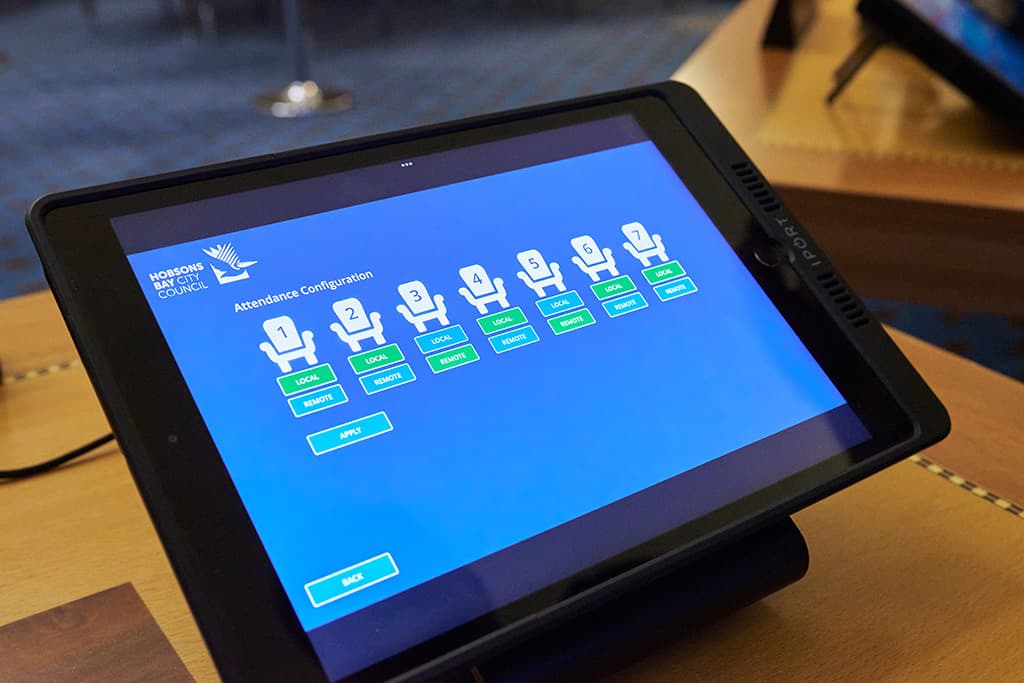
Prior to the meeting, an operator must select which councillor is attending in person or remotely. Q-SYS and MVI does the rest.
ORDER ORDER
A council meeting is a monthly event. And although many aspects of the AV system shares much with a set/forget Zoom Room conference space, some human management and intervention was always going to be necessary. That said, the design of the AV system keeps hand-cranking to a bare minimum.
An iPad GUI leverages Q-SYS control to get the meeting running in no time flat. The most important prompt is for a tech to select which of the seven councillors is local or remote. By toggling between the two possibilities for each, Q-SYS launches the correct ‘brady bunch’ stream configuration (one of 140-odd layouts configured within MVI EasyConf).
The stream itself (hosted by YouTube) is run through a Lumens LC200 device. The LC200 can handle four sources (out of the MVI PC) and provides a quad view to the stream.
Input 1: ‘Brady bunch’ view of all seven councillors.
Input 2: The active speaker (which can be split up to four ways if multiple speakers have their mics open).
Input 3: Dynamic view – Captures local active speakers up to a maximum of four participants based on mic mute status, and typically shows the chairperson/mayor’s camera. If no one’s speaking, it will revert to a wide shot.
Input 4: Agenda/content.
The Lumens LC200 has the capacity to take care of titling etc, but in this case that’s all provided by MVI. It does display a hold screen if the council is conducting an in-camera discussion or if there’s a break for any other reason.
“”
sit in the correct chair, press the button to unmute their microphone, and everything else seamlessly happened in the background
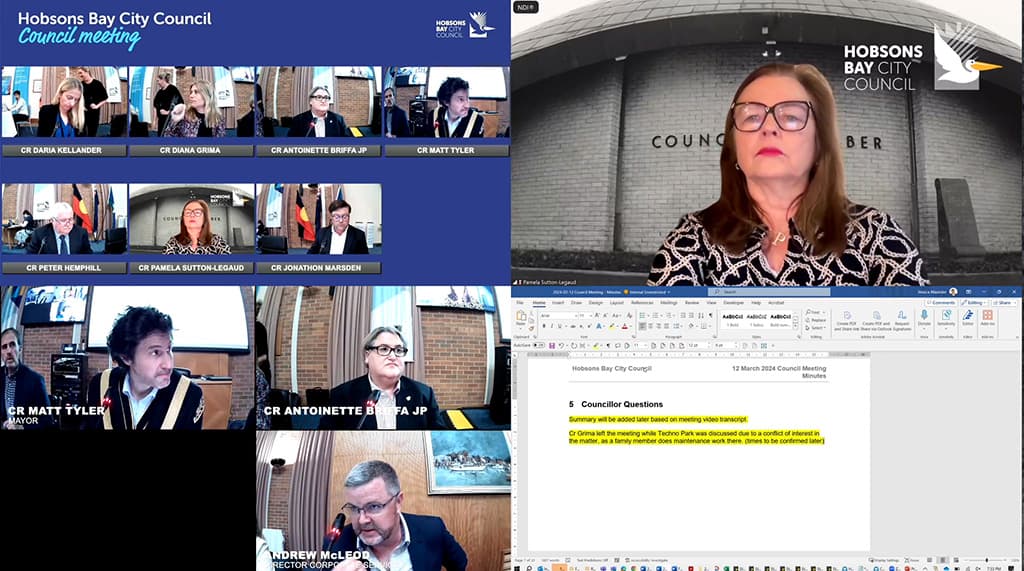
The stream’s quad view. The Lumens LC200 accepts four virtual camera feeds from MVI.
GALLERY VIEW
The in-chamber experience has been improved for those in the gallery. An existing Epson GU7500UNL laser projector with a long-throw lens casts a bright and detailed image on the main projection screen, displaying the agenda/content. Alongside the projection screen is a large LCD that displays remote participants.
In-room audio is all on the network as well (Dante), with Q-SYS providing audio DSP to ensure maximal clarity. QSC AD-S802T column loudspeakers provide sound reinforcement in the space, amplifying speech for the remote participants and voice lift for those in the room.
ROLE OF TECH
Much is made of the role of technology in communications. Often the aim is to render technology as invisible as possible – the more technology imposes itself on the process the more it can tamper with the result. Council meetings are different. They’re inherently highly structured and the process needs to be transparent not the technology.
Converged Technology’s solution might impose a technology overlay – with the lipstick camera, 13-inch display and the Dicentis conferencing panel at each desk – but its doing democracy a favour in the process. The technology quotient might be high but the usability is also high: “Our councillors were naturally a little apprehensive about the new system and its usability,” recall Roger Verwey. “We reassured them that all they needed to do was sit in the correct chair, press the button to unmute their microphone, and everything else seamlessly happened in the background. I think many remained sceptical but were instantly won over when it came time to use the system in a council meeting.”
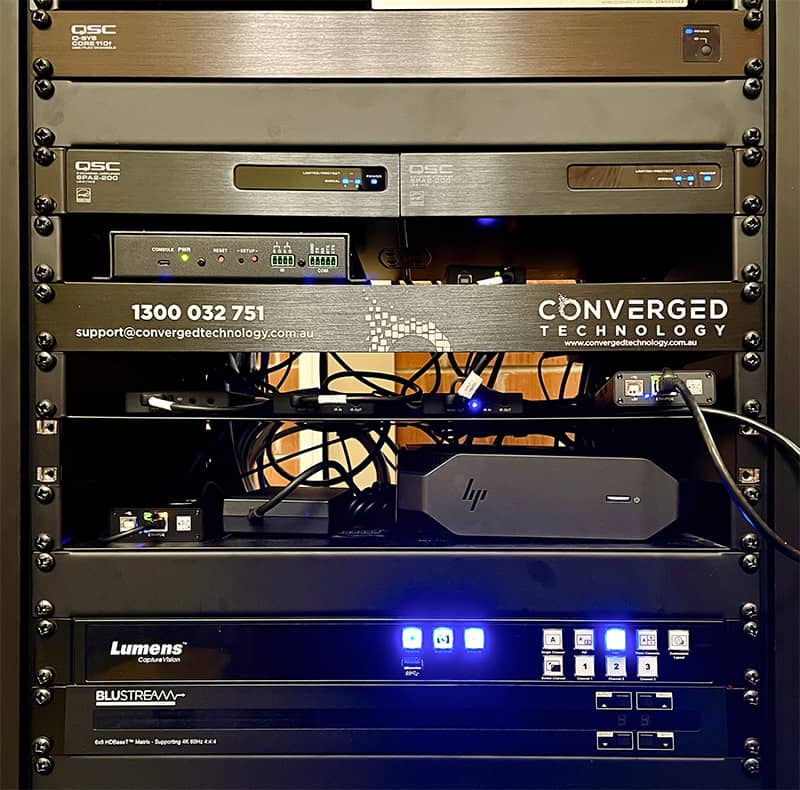
LUMENS LC200
James Frost: We do a lot of Lumens, so we are comfortable with the product. We’ve used the LC200 in some other auditoriums and in education applications. The more recent LC300 can do all NDI, in our case, we had to use Magewell NDI-to-HDMI converters on a couple of inputs. It’s got an API, it’s got multiple inputs, it supports NDI, supports RTP encoding and streaming out to the internet, which is ultimately what it’s here for. And it’s priced well.


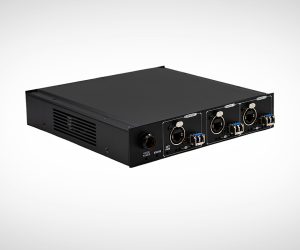


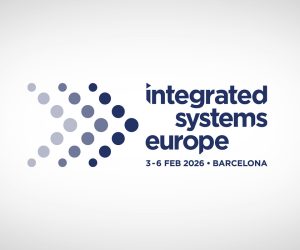
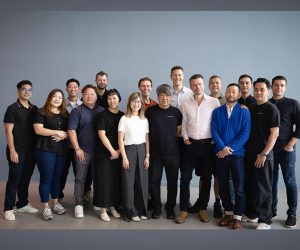





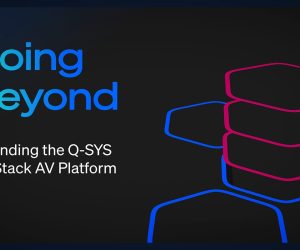
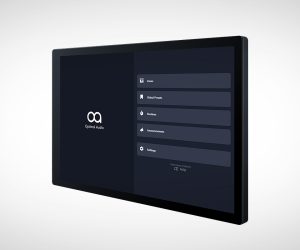


RESPONSES